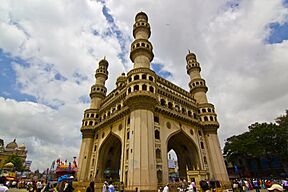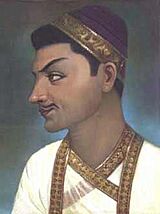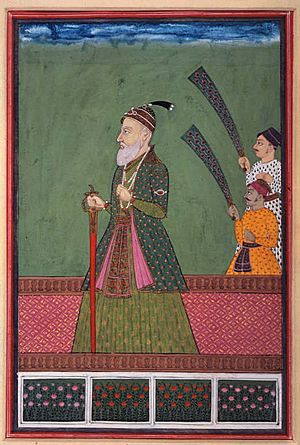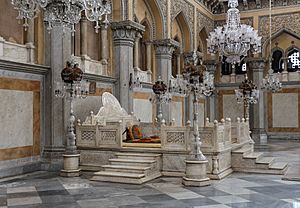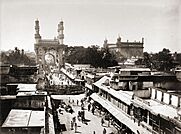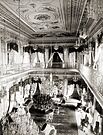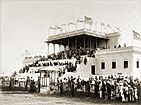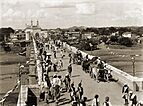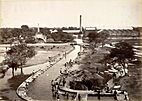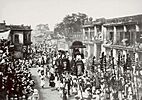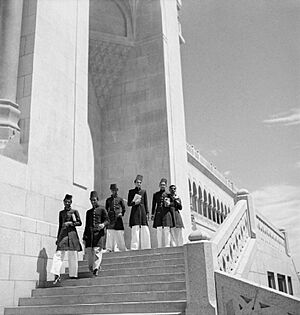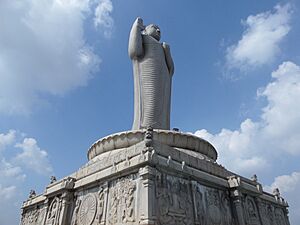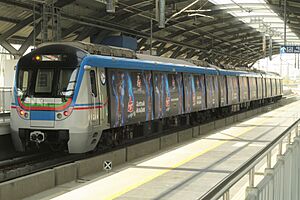History of Hyderabad facts for kids
Hyderabad is a famous city in Telangana, India. It's known for its many old buildings, temples, mosques, and busy markets. Over the last 400 years, many different cultures have shaped the city.
The city of Hyderabad was started by Sultan Muhammad Quli Qutb Shah of the Qutb Shahi dynasty in 1591 CE. It was built around the Charminar, which became the city's main landmark. Hyderabad grew into an important place for trading diamonds and pearls, and a center for art and culture.
After a short time under Mughal rule, the first Nizam of Hyderabad took control of the city in 1724. Later, the Nizams made an agreement with the British. Their land became Hyderabad State, the biggest princely state in British India, with Hyderabad as its capital. During this time, industries, railways, modern education, and air travel grew in Hyderabad.
After India became independent in 1947, the Nizam did not want his state to join the new country. His power was already weaker because of the Telangana movement. The Indian Army took over Hyderabad in 1948. In 1956, Hyderabad State was divided based on different languages spoken there. The city of Hyderabad then became the capital of Andhra Pradesh.
Contents
Ancient History: Early Times in Hyderabad
Archaeologists have found old sites near Hyderabad from the Iron Age, around 500 BCE. The area was ruled by the Mauryan Empire in the 3rd century BCE, during the time of Ashoka the Great.
After Ashoka died in 232 BCE, the Mauryan Empire became weaker. The Sātavāhanas, who were once part of the Mauryan dynasty, became independent. They set up their own empire in this region. The Sātavāhana Empire ruled much of the Deccan plateau and central India for about 450 years, from 230 BCE to 220 CE.
After the Satavahana Empire ended around 210 CE, the Ikshvaku dynasty took over. Their capital was Nagarjunakonda, named after Nagarjuna, a famous Buddhist teacher.
Medieval History: Forts and Kingdoms
Many Buddhist and Hindu kingdoms ruled the area in the centuries that followed. The Chalukya kings ruled the area for a time. When their kingdom weakened, the Kakatiyas, who were their local leaders, became independent. They built their kingdom around Warangal.
The Kakatiyas built the Golkonda Fort near Hyderabad. It was part of their defenses in the west. The fort was built on a granite hill, about 120 meters (390 feet) high. It was surrounded by huge walls. Rani Rudrama Devi and her successor Prataparudra rebuilt and made the fort stronger.
In 1321 CE, forces from the Delhi Sultanate under Muhammad bin Tughluq took over Warangal. This caused chaos in the region. Later, the Musunuri Nayaks took control of Golkonda Fort. They defeated the Tughlaqi army.
For the next few decades, the Bahmani Sultanate fought the Musunuri Nayakas and the Vijayanagara Rayas for control of the region. In 1364, the Golkonda fort was given to the Bahmani Sultanate as part of a peace agreement. By the mid-15th century, the Bahmani Sultanate firmly controlled the region.
Under the Bahmani Sultanate, Golkonda slowly became more important. Sultan Quli Qutb-ul-Mulk (who ruled from 1487–1543) was sent as a governor to Telangana. He made Golkonda his main base around 1501. The Bahmani rule slowly weakened. In 1538, Sultan Quli became fully independent. He started the Qutb Shahi dynasty in Golkonda. Over 62 years, the first three Qutb Shahi sultans expanded the mud fort into a huge granite fortress. It was about 5 kilometers (3 miles) around. Golkonda remained the capital until 1590. Then, the capital moved to the new city of Hyderabad.
Timeline of Rulers
Here's a quick look at who ruled the region:
- Chalukya dynasty (624–1075)
- Kakatiya dynasty (1158–1321)
- Khalji dynasty (1290–1320)
- Tughlaq dynasty (1320–1414)
- Musunuri Nayakas (1336–1365)
- Bahmani Sultanate (1347–1527)
- Qutb Shahi dynasty (1518–1687)
- Mughal Empire (1526–1857)
- Asaf Jahi dynasty (1724–1948)
- Republic of India (1948-today)
The Qutb Shahi Dynasty (1518–1687)
Starting the Golconda Sultanate
In 1463, Sultan Muhammad Shah Bahmani II sent Sultan Quli Qutb-ul-Mulk to the Telangana region. His job was to stop problems there. Sultan Quli did this well and was rewarded. He became the administrator of the region. He set up his base at the Kakatiya hill fortress of Golconda. He made it much stronger and bigger. By the end of the century, Quli ruled from Golconda as the subedar (governor) of Telangana. He was almost independent from Bidar, where the Bahmani sultanate was based.
In 1518, the Bahmani Sultanate broke into five different kingdoms. Sultan Quli declared his independence from the Bahmani Sultanate. He started the Golconda Sultanate and took the title "Sultan Quli Qutub Shah." He rebuilt the old mud-fort of Golconda and named the city Muhammad Nagar.
The Hussain Sagar lake was built in 1563. This was during the rule of Ibrahim Quli Qutb Shah, the fourth Sultan. It was named after Hussain Shah Wali, who helped design it.
Founding of Hyderabad
In 1589, Muhammad Quli Qutb Shah, the fifth ruler of the Qutb Shahi dynasty, chose the current location for the city. He built Hyderabad on the banks of the Musi river. This helped solve water shortages that Golconda had. The Purana Pul (old bridge) made it easy to travel between Golconda and Hyderabad.
There are different ideas about how the city got its name. One popular story says the sultan named it "Bhaganagar" or "Bhāgyanagar." This was after Bhāgmathi, a local dancing girl he loved. She later became a Muslim and was called Hyder Mahal. The city was then renamed Hyderabad in her honor. Another idea is that the city was named after Haidar, Quli Qutb Shah's son. Some historians say the story about the dancing girl is just a made-up tale.
According to historian Pushkar Sohoni, Hyderabad was founded in 1591 to make Golconda less crowded. Golconda was growing very fast. Also, changes in trade and war technology meant that cities for people and businesses needed to be separate from military forts. Andrew Petersen, who studies Islamic architecture, says the city was first called Baghnagar (city of gardens).
Muhammad Quli Qutb Shah ordered the building of the Charminar in 1591. The nearby Makkah Masjid also started construction during his rule. But it took a hundred years to finish. Mir Momin Astarabadi, the prime minister, planned the city of Hyderabad. This included where the Charminar and Char Kaman would be.
Hyderabad Grows
Hyderabad's early history is closely linked to the Qutb Shahi dynasty. In the 16th and early 17th centuries, Hyderabad became a major center for trading diamonds. All eight Qutb Shahi sultans supported learning and were great builders. They helped grow Indo-Persian and Indo-Islamic literature and culture in Hyderabad. Some sultans also supported local Telugu culture.
During the Qutb Shahi rule, Golconda became one of the world's top markets for diamonds, pearls, steel, weapons, and printed fabrics. In the 16th century, the city grew to hold the extra people from Golconda. It eventually became the capital for the Qutb Shahi rulers. Hyderabad became known for its baghs (gardens) and pleasant weather.
Mughal Conquest and Rule (1687–1724)
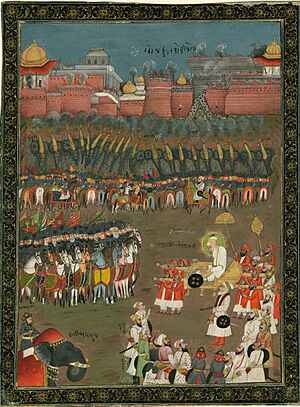
By the mid-17th century, big changes were happening in the Deccan region. Mughal prince Aurangzeb spent most of his time fighting local kingdoms. He wanted to make sure the Mughal Empire was in charge. After Shah Jahan died in 1666, Aurangzeb became Emperor in Delhi. He then returned to the south. He spent most of his time in military camps in the Deccan. He was trying hard to expand the empire even further than it had been under Akbar. The city of Hyderabad was very rich and protected by the strong fort of Golconda. This was a big prize for him.
Aurangzeb and his commanders Khwaja Abid Siddiqi and Ghazi-ud-Din Feroze Jung attacked Golconda in 1686. Golconda held strong for months under the attack. Aurangzeb had to leave, feeling frustrated. He came back in 1687 and attacked for 9 months. He camped in the Fateh Maidan ("victory field"). Khwaja Abid Siddiqi died during this war.
On September 21, 1687, the Golkonda Sultanate came under the rule of the Mughal emperor Aurangzeb. This happened after a year-long attack on the Golkonda fort. The city of Hyderabad was renamed Darul Jihad (House of War). The main areas of the Golconda Sultanate became the province of Hyderabad Subah. Mughal rule in Hyderabad was managed by three main governors.
Aurangzeb's efforts did not last long. Hyderabad stayed under Mughal rule for less than 40 years. During this time, the Makkah Masjid (which started in the 16th century) was finished. Also, the city wall of Hyderabad with 12 gates was completed.
For a few decades, Hyderabad declined. Its busy diamond trade was almost destroyed. Aurangzeb's focus soon moved to other parts of the Deccan. The Maratha Empire started gaining power against the Mughals.
The Nizams of Hyderabad (1724–1948)
Hyderabad State, with its capital Hyderabad, was the largest princely state in India. It was bigger than England, Scotland, and Wales combined. It was considered the "senior-most" princely state. Its ruler, the Nizam, received a 21-gun salute from the British. Modern facilities and industries started to develop in Hyderabad city in the late 19th century. The State had its own money, mint, railways, and postal system. The Nizam became very rich from the diamond trade.
Asaf Jah I: The First Nizam
The Mughal Empire became weaker after Aurangzeb died in 1707. The Mughal governors of Hyderabad gained more power from Delhi. In 1714, the Mughal Emperor Farrukhsiyar appointed Mir Qamar-ud-din Siddiqi as the viceroy (a ruler representing the king) of the Deccan. He was given the title Nizam-ul-Mulk (governor of the country). He was well-suited for this job. He had fought alongside his father and grandfather during the siege of Golconda.
In 1724, he defeated Mubariz Khan to take control of Hyderabad. He received the title Asaf Jah from Mughal Emperor Muhammad Shah the next year. This was the start of the Asaf Jahi dynasty. This family would rule Hyderabad until a year after India became independent from Britain.
Nizams After Asaf Jah I
When Asaf Jah I died in 1748, there was a period of political trouble. His sons fought for the throne. Neighboring states and foreign powers supported different sons. The rule of Asif Jah II, from 1762 to 1803, brought stability. In 1768, he signed a treaty. He gave the coastal region to the East India Company for a yearly payment.
In 1769, Hyderabad city officially became the capital of the Nizams. The Nizam signed an agreement with the East India Company in 1798. This allowed the British Indian Army to be stationed at Bolarum (now Secunderabad) to protect the capital. The Nizams paid the British yearly for this.
The Nizams became friends with both the British and the French at different times. They played an important role in the Anglo-Mysore Wars.
During the rule of the third Nizam, Sikandar Jah, the city of Secunderabad was founded. It was built to house French and later British troops. The British had a representative (Resident) in Hyderabad and their troops in Secunderabad. But the Nizam still ruled the state. Paying for the British forces was a heavy burden on Hyderabad state. It led to financial problems in the early 19th century.
Asaf Jah V: Reforms and Rebellions
Asaf Jah V's rule saw many reforms. His Prime Minister, Salar Jung I, started a central government treasury in 1855. He improved the tax and justice systems. He also started a postal service and built the first rail and telegraph networks. The first higher education school in Hyderabad, Dar-ul-Uloom, was also set up during his time.
News of the Indian Rebellion of 1857 reached Hyderabad. Turrebaz Khan and Maulvi Allauddin led about 5,000 people in attacks on the British Residency. However, the British troops were stronger, and the rebellion was quickly stopped.
Asaf Jah VI: Growth and Flood
Asaf Jah VI Mir Mahbub Ali Khan was the sixth Nizam of Hyderabad. He ruled from 1866 until his death in 1911. He became ruler at age three. His regents, Salar Jung I and Shams-ul-Umra III, ruled for him. The Nizam took full control at age eighteen.
The Nizam's Guaranteed State Railway was started in 1879. This railway company was fully owned by the Nizam. It was built to connect Hyderabad with the rest of British India. Its main office was in Secunderabad Railway Station. After independence, it became part of the Indian Railways. Railways also brought industry to Hyderabad. Four factories were built south and east of the Hussain Sagar lake.
By 1901, Hyderabad city had 448,000 people. This made it the fourth most populated city in British India. The surrounding Hyderabad State had 11 million people.
The Great Musi Flood of 1908 badly damaged the city during his rule. About 15,000 people died, and at least 200,000 were affected. All bridges over the River Musi were destroyed, except for the Purana Pul. The Nizam opened his palace, Purani Haveli, to help the flood victims.
To my horror, I found that three leaks had started and were rapidly extending. The breach of this dam would precipitate an enormous volume of water into the still greater Hosain Sagar Lake, probably cause the dam to burst and thus complete the destruction of Hyderabad city,
—Michael O'Dwyer, British Resident
The flood showed that the city needed better planning. The Nizam invited Sir M. Visvesvaraya to design a flood prevention system for modern Hyderabad. The Nizam died in 1911 at age 45.
Asaf Jah VII: The Last Nizam
The seventh and last Nizam of Hyderabad, Mir Osman Ali Khan, became ruler in 1911.
He started many important places and public buildings in the city. These include the Begumpet Airport, Hyderabad State Bank, Osmania University, Nizamia Observatory, Moazzam Jahi Market, Nizamia Hospital, Assembly Hall, State Central Library, and the Hyderabad High Court. The Nizam also asked British architect Vincent Esch to design some of these. The Nizam even owned an airline called Deccan Airways.
Two large reservoirs, Osman Sagar and Himayat Sagar, were built a few kilometers west of Hyderabad. This was to prevent another flood in the city, based on advice from Sir M. Visvesvaraya.
He was known for his huge wealth and large jewel collection. This included 173 jewels, like the famous Jacob Diamond. He was called the richest man in the world in 1937. He appeared on the cover of Time magazine. This wealth came mostly from the Golconda mines, which produced many diamonds.
Many industries started in Hyderabad before India's independence, during Asaf Jah VII's rule. Major industries were set up in different parts of Hyderabad and nearby areas:
| Company | Year |
|---|---|
| Karkhana Zinda Tilismat | 1920 |
| Singareni Collieries | 1921 |
| Vazir Sultan Tobacco Company, Charminar cigarette factory | 1930 |
| Azam Jahi Mills Warangal | 1934 |
| Nizam Sugar Factory | 1937 |
| Allwyn Metal Works | 1942 |
| Praga Tools | 1943 |
| Deccan Airways Limited | 1945 |
| Hyderabad Asbestos | 1946 |
| Sirsilk | 1946 |
Post-Independence (1948–Present)
Joining the Indian Union
When India became independent in 1947, the Nizam wanted to remain independent. He signed an agreement with the Indian Union to keep trade and supplies flowing. But law and order quickly broke down. There was growing violence between the private Razakar army, who wanted the Nizam to stay in power, and people who wanted to join India. These people were supported by leaders like Swami Ramanand Tirtha and communists from Telangana.
As the violence got out of control, many people fled. The Indian Government, led by Home Minister Sardar Patel, started a police action called Operation Polo. On September 16, 1948, the Indian Army entered Hyderabad State from five directions. Four days later, Hyderabad's forces surrendered. The Nizam finally gave up and signed an agreement to join the Indian Union. Hyderabad became a state within India.
Hyderabad State (1948–1956)
The state then got its first democratic government. Its representatives joined the group that wrote the constitution for free India. For the next eight years, Hyderabad State remained a separate state within India, with Hyderabad as its capital.
Idea for a Second Capital
In 1955, B. R. Ambedkar, who helped write the Indian Constitution, suggested that Hyderabad should be India's second capital after Delhi. He felt Hyderabad was a good central location with good facilities. He said, "Hyderabad has all the amenities which Delhi has and it is a far better city than Delhi." This idea came up again in 2014 when Andhra Pradesh was divided.
Hyderabad Today (1956–Present)
On November 1, 1956, the states of India were reorganized based on languages. The 7th Nizam, Mir Osman Ali Khan, was made the Rajpramukh (governor). The areas of Hyderabad State were divided among the new states of Andhra Pradesh, Bombay state (later Maharashtra), and Karnataka. Hyderabad and its surrounding areas, where most people spoke Telugu, became part of Andhra Pradesh. Hyderabad became the capital of this new state. Since 1956, Rashtrapati Nilayam, Hyderabad, has been the second official home and office for the President of India.
HITEC City was started in the 1990s by the Andhra Pradesh government. Today, many big international IT companies like Amazon, Infosys, Microsoft, and HCL have offices in HITEC City. They are also in nearby areas like Gachibowli and Madhapur. In 2005, construction began for the Rajiv Gandhi International Airport. It opened in 2008 and replaced the old Begumpet Airport. It is now one of the busiest airports in India.
The city experienced terrorist bomb blasts in May 2007, August 2007, and February 2013.
Hyderabad also hosted the 2007 Military World Games and the 2009 World Badminton Championships.
In 2014, the Andhra Pradesh Reorganization Act, 2014 created Telangana as a new state. Hyderabad became its capital. The new state was formed on June 2, 2014. K. Chandrashekhar Rao became the first Chief Minister of Telangana. Hyderabad will also remain the capital of Andhra Pradesh for ten years.
The Hyderabad Metro Rail started running in 2017. Many of its routes are still being built.
Images for kids
-
Asaf Jah VII pays respect to King George and Queen Mary, Delhi Durbar, 1911
-
One Hyderabadi Rupee coin issued in 1329 AH (1911 CE) during the reign of Asaf Jah VI
See also
- Etymology of localities of Hyderabad
- 1990 Hyderabad riots


